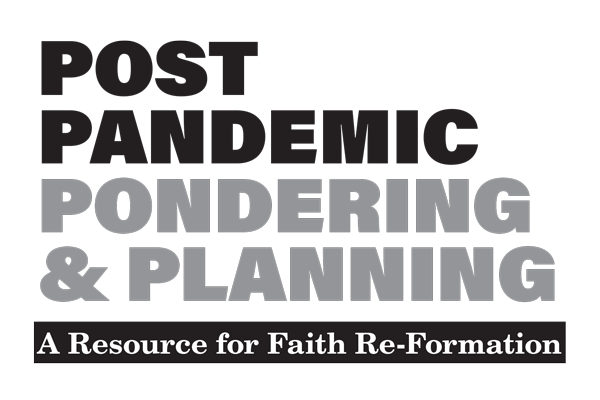Engaging this module
You are invited to explore this module by reading the content, watching the presentations and videos and responding to the suggested exercises and activities. You are encouraged to have a Bible and journaling materials nearby to take notes.
Your Faith Formation
Ministry Path
Faith formation is a lifelong, continuing process that takes place in a community of believers. It involves heart, mind, and soul; therefore, it can be every action, experience, or relationship that nurtures a transformative relationship of trust with God and shapes the way we see and interact with God’s world. As leaders, we have the honor and responsibility to interpret where formation is happening in our faith communities (hint: everywhere!) and to guide our congregation in intentionally engaging in formation throughout their lifetime and as a community. This module will guide you through a process of exploring definitions of faith formation, discerning where you see formation happening and how to support this ministry in your context.
DEFINING FAITH FORMATION
Let’s explore these 2 definitions of faith formation:
Faith formation informs, forms, and transforms the person—whether child, youth, or adult—into a robust, vital, and life-giving Christian faith that is holistic: a way of the head, the heart, and the hands. And faith formation does the very same for the Christian community as it immerses people into the particular practices and particular way of life that identifies them as followers of Jesus.
[T]eaching and learning are not finally about mastery. Our task in learning is not to master the practices or the subject matter or ourselves. And our task in teaching is not to master our students. If, in striving for excellence, we find ourselves in pursuit of control over our own destinies as human beings, seeking to use education in faith as a means to secure ourselves before God, we will have missed the mark entirely. The practices of faith are not ultimately our own practices but rather habitations of the Spirit, in the midst of which we are invited to participate in the practices of God. So, too, education in faith is not ultimately an ethical or spiritual striving but rather participation in the educating work of God’s Spirit among us and within us. In this way, education in faith is itself a means of grace.
REFLECTION
Christian faith formation includes being formed, informed, and transformed by God in Christ through community and practices. Often our own sense of faith formation best practices and values comes from our very own positive and meaningful experiences and memories. As you prepare to reflect on building a faith formation ministry reflect on these three prompts:
-
- Reflect on a time in your life where you felt your faith was formed (when was a door opened for you)
- Reflect on a time in your life where you grew in knowledge around your faith.
- Reflect on a time when your faith, your practices, or your understanding of God was transformed
When you think about those forming, informing, and transforming experiences
-
- Why were these experiences meaningful?
- Where were you? Who were you with? What did you learn and how?
- How do these experiences shape your own love for the ministry of faith formation?
QUESTIONS
Watch this presentation on faith formation definitions. Think about how you define faith formation in your context. What do you see the purpose of your faith formation ministry to be? How do the people you serve and where you serve impact this definition?
- How has your understanding of your ministry (Christian Education, Faith Formation) changed?
- What are the challenges of your model and definition?
- What is thriving? Brings joy and excitement?
WHERE DOES FAITH FORMATION HAPPEN?
In this section we will further explore a variety of models for faith formation and Christian education.
Leaders were invited to share their stories of faith formation. They share creative models set in a variety of ministry settings including worship, with all ages, in households and in mission and service.
As you watch and listen think about the following:
-
- How do the models shared reflect different expressions of faith formation? What description or definition of faith formation do you think each model is explicitly or implicitly using?
Consider:
-
- Who is the intended audience?
- What is the intended outcome?
- Why was the model created?
- How does the model hope to accomplish its intended objective?
QUESTIONS
Which model is the most intriguing or exciting to you, and why?
What resources would be required to adapt or replicate this program for your setting?
FAITH FORMATION PATH
You will now follow this path and the steps of discerning your own ministry. Grab some paper and your favorite writing and coloring tools! Open each step with the key icon and work through the exercise before moving to the next step. You may need to pause and come back when you are ready.
STEP 1
WHERE ARE YOU?
Now that you’ve seen some examples of innovative faith formation programs and models, take a moment to stop and think about where you are before you begin creating new opportunities for your setting.
- Start by listing the faith formation opportunities offered in your setting. Remember to include: discussion groups, Bible studies, classes, special events (like VBS or special speakers), prayer groups, special programs, service learning, certain community-building events, resources to use at home, worship, and participation in the sacraments.
-
Indicate next to each offering (perhaps in a different color) the intended audience or participants. You’ll need this list as you move on to step 2.
STEP 2
DISCERNING PRIORITIES
Look at your list. Spend some time in prayer about how these faith formation opportunities are working in your context. Consider the following:
- Life Giving: What do we do well? What do we want to keep doing?
- Life Depleting: What do we need to stop doing altogether? What is unnecessary?
- It’s Messy: What are we doing that is missing the mark but has potential?
Then,
- circle what is life giving
- put an X next to what you might need to stop doing
- put a ? next to what is messy and may need some changes
STEP 4
WHERE ARE YOU GOING?
Let’s think about the new program or model you might create.
- Describe a new formation model you’d like to offer.
- How would you describe the intended audience/learners? They might be grouped by common characteristics, like being in the same stage of their physical, emotional, cognitive development. It might be by “where they are” in life. Are they caregivers of young children? Retired or semi-retired? Are they young adults, youth, or children? It might be by interest.
- Where could (or should) you meet? Think creatively. Besides a classroom or the church basement, could you meet on the church grounds, in a park, at someone’s house?
STEP 3
WHO (OR WHAT) IS MISSING?
- Who is not served by these opportunities? You might group people by age, stage in life, interests, or location flexibility (some groups are limited by acceptable/appropriate meeting location).
- Is there an area of your congregation’s life that is not represented by your current models?
STEP 5
TO FORM, INFORM, OR TRANSFORM?
- What do you want your program participants to know?
- What do you want your participants to be able to do?
- What is its role? Does it form, inform, or transform faith?
- Why is the program you’re suggesting needed? What need does it fill?
STEP 6
WE ARE…
You have worked through this path, discerning what your programs look like and how your ministry might be refreshed and what space could be made for new! You are invited to spend some time thinking of five words that describe faith formation in your ministry setting. Consider posting these somewhere you can see them!
- ____________
- ____________
- ____________
- ____________
- ____________
The pandemic has changed the way we do ministry and we have tools to help you further discern your programs.
FAITH FORMATION PATH
You will now follow this path and the steps of discerning your own ministry. Grab some paper and your favorite writing and coloring tools! Open each step with the key icon and work through the exercise before moving to the next step. You may need to pause and come back when you are ready.
STEP 1
WHERE ARE YOU?
Now that you’ve seen some examples of innovative faith formation programs and models, take a moment to stop and think about where you are before you begin creating new opportunities for your setting.
- Start by listing the faith formation opportunities offered in your setting. Remember to include: discussion groups, Bible studies, classes, special events (like VBS or special speakers), prayer groups, special programs, service learning, certain community-building events, resources to use at home, worship, and participation in the sacraments.
- Indicate next to each offering (perhaps in a different color) the intended audience or participants. You’ll need this list as you move on to step 2.
STEP 2
DISCERNING PRIORITIES
Look at your list. Spend some time in prayer about how these faith formation opportunities are working in your context. Consider the following:
- Life Giving: What do we do well? What do we want to keep doing?
- Life Depleting: What do we need to stop doing altogether? What is unnecessary?
- It’s Messy: What are we doing that is missing the mark but has potential?
Then,
- circle what is life giving
- put an X next to what you might need to stop doing
- put a ? next to what is messy and may need some changes
STEP 3
WHO (OR WHAT) IS MISSING?
- Who is not served by these opportunities? You might group people by age, stage in life, interests, or location flexibility (some groups are limited by acceptable/appropriate meeting location).
- Is there an area of your congregation’s life that is not represented by your current models?
STEP 4
WHERE ARE YOU GOING?
Let’s think about the new program or model you might create.
- Describe a new formation model you’d like to offer.
- How would you describe the intended audience/learners? They might be grouped by common characteristics, like being in the same stage of their physical, emotional, cognitive development. It might be by “where they are” in life. Are they caregivers of young children? Retired or semi-retired? Are they young adults, youth, or children? It might be by interest.
- Where could (or should) you meet? Think creatively. Besides a classroom or the church basement, could you meet on the church grounds, in a park, at someone’s house?
STEP 5
TO FORM, INFORM, OR TRANSFORM?
- What do you want your program participants to know?
- What do you want your participants to be able to do?
- What is its role? Does it form, inform, or transform faith?
- Why is the program you’re suggesting needed? What need does it fill?
STEP 6
WE ARE…
You have worked through this path, discerning what your programs look like and how your ministry might be refreshed and what space could be made for new! You are invited to spend some time thinking of five words that describe faith formation in your ministry setting. Consider posting these somewhere you can see them!
- ____________
- ____________
- ____________
- ____________
- ____________
The pandemic has changed the way we do ministry and we have tools to help you further discern your programs.
WHAT’S NEXT
Rooted Good and the PC(USA) Office of Christian Formation have created What Next: A creative tool to help ministries and communities of faith re-imagine our programs and life together.
RE-FORMING THE FAITH FORMATION PROGRAM
The COVID pandemic left many Christian education and formation programs in limbo. Congregations have always had to adapt to changing resources, communities, and current events. The Association of Partners in Christian Education (APCE), in partnership with the Office of Christian Formation in the Presbyterian Mission Agency PC(USA), has created a resource for congregations to use in planning future Christian education and formation programs. Post Pandemic Pondering & Planning invites individuals or groups to contemplate both the past and the future. A series of questions guides users through reflections on previous programs and beginning planning for a post-COVID (or continuing COVID) environment.


ADAPTIVE LEADERSHIP AND NEXT STEPS
As you bring together all the exercises you have done in this module, you may have exciting ideas of how to move forward and more clarity about how we join God in practice and community to be transformed. You will need to spend some time discerning your own timeline and how you will move forward. It is important to have someone that you can invite to walk alongside you in this journey, whether it is a journey to develop a model of faith formation for your entire faith community or simply one aspect or program. Ministry is contextual and you will always be adapting. The definitions and models throughout this module need to be critically examined for how they will need to be adapted in your setting.
Questions to guide your plan:
- Imagine your desired outcome. Think about what you will need to do to arrive at that outcome.
- Small wins are important. What steps can you accomplish in 1 week and in 1 month?
- Who will you invite to walk alongside you? How often will you meet with them in order to stay accountable?
This 30 minute presentation is about taking the next steps in discerning new models of faith formation.
Adaptive Leadership is so important in ministry. This presentation from Von Clemans is about taking the next steps in discerning new models of faith formation.
Consider the following questions from the presentation:
- What do you observe when you view your situation “from the balcony?”
- What are you hearing from your people as you listen “from the floor?
- Where is the grief in your situation?
- Where is the energy for growth in your situation?
- Where do you need to be courageous ?

PROGRAM ASSESSMENTS
The Post Pandemic Pondering and Planning resource will help you evaluate your past Christian education and formation program and plan your future program. There will also be times you need to assess the success of a specific offering (for example, a class, gathering, or an event). Download this handout for examples of questions that you can use.

